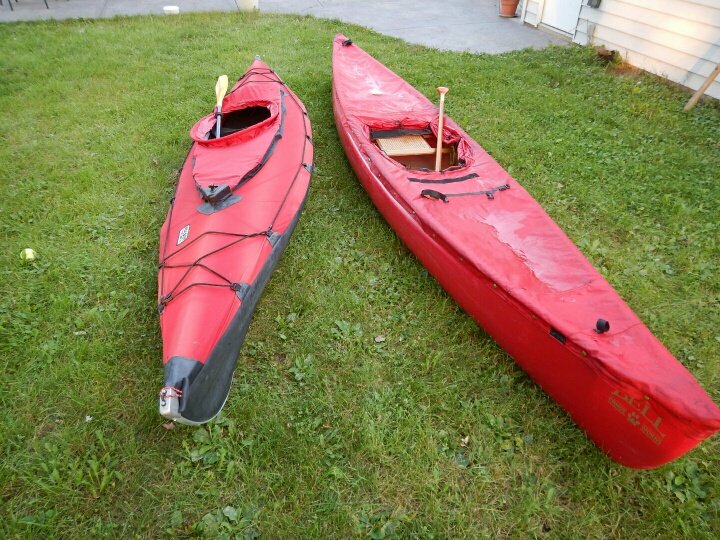
Folbot Yukon kayak (l) and Bell Yellowstone canoe (r)

When I decided to do this river trip, one of the first decisions was about which boat to use. Like a lot of paddlers, there are several boats in our garage. This past spring I bought a used kayak off Craigslist because at 13 feet, it is better for navigating southern Wisconsin streams. And, ever since reading Larry Rice’s books and watching his presentations about trips he has taken with a “boat in bag,” I have been intrigued by folding boats that disassemble and can be taken as baggage on an airplane or bus. This Craigslist score was a Folbot Yukon kayak rigged for expedition use. (My other boats are a 17-foot sea kayak for Lake Superior Apostle Islands trips and a 16-foot canoe for Boundary Water trips.)
But the one problem with kayaks is they are not designed to be portaged—there is no easy way to move them from lake to lake on wilderness trips. They are awkward and often take two people to carry an empty boat, and then only a short distance.
While visiting with my friends Clayton Russell and Kathleen Adee about the Wisconsin River trip Clayton had done in 2012, he offered to let me paddle the boat he had taken on the same trip—a sweet solo Bell Yellowstone canoe. It handles like a dream, responsive to turns, but also has good tracking on big water. Canoes are so much easier to get in and out of over beaver dams and in low water. His boat is outfitted with a snappy spray deck. Canoes are truly a north American form of boat invented by the native Americans who established extensive trade routes using river systems and lakes. A canoe can hold a lot of stuff, and can easily be portaged from one water body to another. I like the idea of using a canoe because it is the traditional watercraft that was used on the Wisconsin River, a major transportation artery in our state’s history. I like canoes the way I like wool, wood paddles and fresh-pressed apple cider.
The Wisconsin River is a strange combination of winding creek with pullover beaver dams in the top third, portages on gravel roads around hydropower dams that create large flowages in the middle, and the wide, windy and wild Lower Wisconsin.
Since I am paddling solo for large stretches of the trip, I came to realize my comfort level in the boat was the most important factor. Despite additional seat padding, I couldn’t keep my feet from falling asleep in the canoe after a few minutes. I also felt a little more vulnerable to the wind. I am most secure in a kayak where I am seated on the bottom of the boat with a low center of gravity; not catching as much wind–so I’ll use the kayak for this trip.

In the canoe, you are seated (or kneeling) and have a better view, but catch more wind. A canoe is easier to portage by carrying it upside down on your shoulders with a yoke. In the kayak you are sitting on the bottom of the boat. It is harder to get in and out of the boat and portaging will require a cart or extra help.
How will I do the portages with a kayak? The portages I’ve seen around hydropower dams are dirt roads or even golf courses! I’m not totally sure this will always work, but I have built a sturdy cart to roll the kayak across portages. There may be rocky, forested trails or steps where a cart won’t work and the worst scenario will be to portage my gear, disassemble the kayak and carry the frame and skin over separately. I’ll let you know how that turns out!
In addition, I’ve put together a plan where I will get some help around about half of the 26 dams on the river. I won’t be paddling every inch of the 430 miles, in fact, I’ll be going off river for about 87 miles to avoid some dams and their associated big-water flowages. These accommodations and choices help keep the trip within my time schedule and realm of experience. As much as I love that Bell Yellowstone canoe, this trip will be with the Folbot Yukon kayak.
